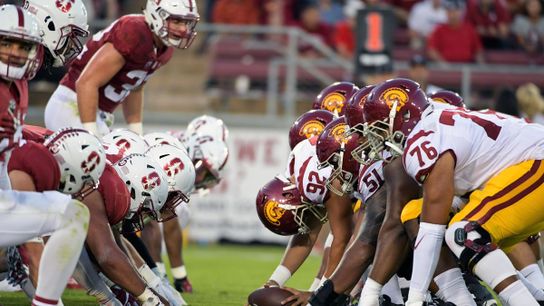The college sports industry is sorting through the rubble of the Transfer Portal and NIL earthquakes, but an even bigger quake could be on the way.
The California State Assembly is in the process of debating and refining SB-1401, which would require the state's colleges and universities to share a portion of their revenue with football and basketball players.
Thanks to the Los Angeles Times, we have some new details on the bill that could revolutionize college athletics once and for all.
Per the LA Times, SB-1401 has centered on football and men's and women's basketball because those are the only three sports where scholarships don't account for 50 percent or more of the revenue generated by that sport. And so the California legislature is zeroing in on that, with the stated goal of boosting graduation rates and building wealth among athlete populations that are majority Black.
How would the revenue be split up? From the Times:
The amount owed to each athlete would be the half of the sport’s total revenue minus the team’s total student grant-in-aid package divided by the number of players.
Let's say USC football generates $50 million a year and spends $10 million on football scholarships. For the entire history of college athletics, USC has kept that remaining $40 million and spent it as it sees fit. If SB-1401 passes as it's currently written, $20 million that has funded Olympic sports and paid administrators' salaries would disappear from the budget and reappear in a fund for Trojans football players.
The paper estimates each USC player could earn up to $200,000 per year -- in addition to whatever they garner on the NIL market.
The payment system would work like this: Athletes would have access to up to $25,000 per year, and the rest would go into a fund that he or she would receive upon graduation. If a player transferred to another California university, the funds would transfer with them. If a player transferred out of state, their funds would be forfeit and return to the pool.
The bill would not classify athletes as employees.
A path to a compromise of sorts has emerged. The Times reports that lawmakers have discussed amending the bill to set aside 50 percent of only the new money each football and basketball program generates. This would be akin to a profit sharing system as a opposed to a salary.
This, undoubtedly, is the path that the state's universities are trying to push their lawmakers down, as a straight 50 percent split could have apocalyptic consequences on the Olympic sports at USC, UCLA, Cal and Stanford -- a pride point on each of those four campuses. Those representing the interests of football and basketball players have argued that it is not, and never should have been, their job to fund the water polo team's budget.
So, the USC golf coach could be in AD Mike Bohn's office demanding he do everything he can to kill SB-1401, while Lincoln Riley could look at his recruiting board and wonder how much easier it'd be to keep his local targets home with a $200,000 per year nest egg (so long as he graduates).
SB-1401 could form a framework for the future of college football. Ohio State AD Gene Smith joined the growing chorus of voices to wonder aloud if the path forward is to split football off into an organization wholly separate from the NCAA, while every other sport remains.
Funded by new contracts for an expanded College Football Playoff plus new TV deals for every Power 5 league, it's not difficult to squint into the horizon: a collectively-bargained contract with players that pays them a portion of football-specific revenue (which would be paid for out of the new deals, thereby not cutting anyone else's budget) that comes with concessions on the players' side on Transfer Portal movement.
Where does the bill stand now? Per the LA Times, SB-1401 has passed through the Senate education and judiciary committees and now sits with the appropriations committee. From there, it would move to the greater Senate floor. Passage there would move it to Governor Gavin Newsom's desk.
It's not a guarantee SB-1401 passes, and it's even less of a guarantee it passes in its current form. The legislative process exists to water bills down, and that could happen here. It's also no guarantee that SB-1401 ignites the same grass fire that the Fair Pay to Play Act did, since all those state NIL bills that ultimately got us to this point did not move money around within athletics department's budgets. SB-1401 is much more radical, and so it's possible that other state legislatures take a wait-and-see approach, particularly if the bill's effective date is not until 2024 or '25. (The Fair Pay to Play Act originally was not designed to go into effect until Jan. 1, 2023. So much for that.)
Jon Wilner wrote that Cal, Stanford and "possibly" UCLA would give serious thought to dropping out of FBS if SB-1401 passes in its current form, so there's one side of it. On the other side, future recruits could be so impressed by the opportunity to leave college with hundreds of thousands of dollars in the bak (so long as they graduate) that the balance of power in college football shifts West, forcing other states to respond.
Reality likely sits somewhere in the middle, but where, exactly, is anyone's guess.
We'll know Thursday whether or not SB-1401 made it out of the appropriations committee, so the next 48 hours could be crucial for the future of college athletics.
Thursday Update: The bill is unlikely to pass.
A bill in California Senate that would have required schools in state to share revenue with college athletes is going to fail to pass Appropriations Committee, according to staff for bill's sponsor, Steven Bradford. Appropriations approval would have moved bill to Senate floor.
— Steve Berkowitz (@ByBerkowitz) May 19, 2022
